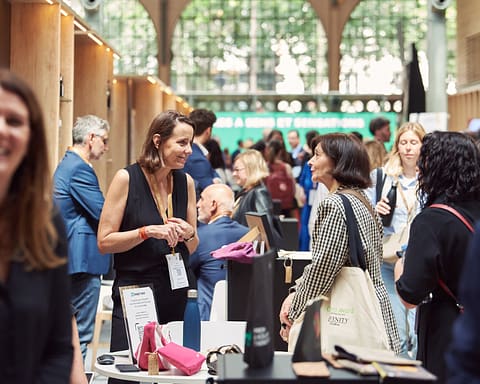[vc_row njt-role=”people-in-the-roles” njt-role-user-roles=”administrator,editor,author,armember”][vc_column][vc_column_text]
The outfit of Brigitte Macron, who came to celebrate the election of her husband at the Champ-de-Mars, did not escape the connoisseurs. In her navy blue suit with silver buttons, they recognised the First Lady’s favorite label, Louis Vuitton. In 2017, she had already chosen LVMH’s flagship company for Emmanuel Macron’s first election.
This choice has given rise to contrasting reactions, just like the assessment made by the fashion and luxury industry players on the first five-year term of the leader of the République En Marche.
Some, like Pierre-François le Louët, President of the French federation of women’s ready-to-wear clothing (Ffpapf) and director of the consultancy agency Nelly Rodi, see in it Brigitte Macron‘s “role as an ambassador for fashion and luxury in France and abroad”. A mission that had not been made possible by “the previous configuration under François Hollande”. Others regret that the First Lady did not take advantage of these high-profile occasions to put forward other designers, rather like Michelle Obama did. But Pierre-François le Louët notes that while Brigitte Macron has a special relationship with Louis Vuitton, she has also worn outfits from other houses, such as Balmain and Barbara Bui, over the past five years.
In addition to the mission of the First Lady, Pierre-François le Louët salutes a strong symbolic gesture during the first Macron quinquennium, namely the organisation of two Fashion Dinners at the Elysée, in 2018 and 2020, bringing together numerous representatives of the industry, designers, brands, manufacturers. “This had not been done since the 1980s.”
But for the President of the Ffpapf as well as for Clarisse Reille, the General Director of the Défi, the professional committee for the economic development of clothing, “the great positive contribution of the Macron quinquennium was the setting up in 2018 of the new CSF (strategic committee of the sector) Fashion and Luxury with the appointment at its head of Guillaume de Seynes, the General Director of Hermès“. It is moreover Pierre-François le Louët, with Pascal Morand, the Executive President of the Federation of Haute Couture and Fashion and Yves Dubief, the President of the Union of Textile Industries (Uit), who pleaded at Bercy for the creation of this structure bringing together representatives of public authorities and the sector (companies and trade unions). “What existed before did not work”. The Fashion and Luxury Csf was based on a “much stronger and more solid will”, by being supported by two ministries, the economy and culture.
Birth of the new French Fashion Institute
Among the “structuring actions” linked to this CSF, “there is the inauguration at the end of 2021 of the new Ifm, born from the merger of the former French Fashion Institute and the School of the Chamber of Fashion. This was financed mainly by the big luxury houses, but also in part by the State and by the Défi, and the State has more widely supported this project in its implementation”, underlines Clarisse Reille.
Another initiative, this time financed by the Défi, the technical centre of leather (CTC), France Eclat, the Union of Textile Industries (Uit) and the Opcos (organisations approved by the State for continuous training), the Savoir pour faire campaign was launched in 2019, to raise awareness among young and not-so-young people of the manual professions of the sector.
“There was also the creation in 2019 of the “Fashion and Luxury” accelerator, an intensive support programme for emerging brands. In addition to funding from the Public Investment Bank (BpiFrance), this project is also supported by the Défi, the CTC and France Eclat. Finally, a sustainable fashion action, to help companies in their traceability approach, has just been launched” indicates Clarisse Reille. On the industrial level, “the recovery plan, set up by the State since the arrival of covid, has benefited the upstream industrialists of the sector”.
Another structuring moment for the sector, the Fashion Forums, organised every year since 2016 (in person or digitally, as was the case for the fifth edition, on 1 April last), and enabling the players in the sector to take stock of the major issues in the sector, have continued to be financially supported by the Ministries of the Economy and Culture. The Ministry of Culture has also instituted calls for projects for creators and handicrafts, Clarisse Reille points out.
For Pierre-François le Louët, finally, the great novelty of the quinquennium was also the fact that CSR was “at the heart of the reflection for the future of fashion and luxury”. “Our federation had already highlighted this theme in a study six years ago. And the public authorities, with the Anti-waste for a responsible economy (Agec) law (2020) and then the Climate-Resilience law (in 2021), have also put these concerns at the top of the agenda.”
The government was also “key in launching the Fashion Pact”, adds Clarisse Reille. Prompted by a mission entrusted by Emmanuel Macron to François-Henri Pinault, CEO of Kering, this global coalition of fashion and textile companies, from the mass market to luxury, committed to major environmental challenges, was presented in August 2019 to the Heads of State gathered for the G7 Summit in Biarritz.
Caveats
However, there are a few reservations.
“On sustainable fashion, there has been a kind of regulatory overload. Companies are subject to a lot of requirements but receive little support to reduce their environmental impact, for example in their eco-design initiatives,” regrets a sector representative.
On the issue of environmental labelling, the government initially wanted to impose it from 1 January 2022, based on the Ademe model. “But this was a real gas factory, very expensive and whose results were not necessarily accurate. So it launched an alternative display system”. Among the eleven systems selected for testing are those of the Fédération de la Haute Couture et de la Mode and Le Défi.
The industry is also concerned about the way in which the collection tax credit has been called into question by a recent case law of the Conseil d’Etat, “which de facto excludes designers from the scheme”. “The collection tax credit is now only applicable to creation closely linked to manufacturing.” Moreover, the scheme is due to expire at the end of 2022. The federations of the sector have taken up the cause with the Ministry of the Economy and will be very attentive to the fact that such a collection tax will once again benefit creators
Another concern is that the tax deduction for companies using industrial technical centres for R&D work has been halved from 2022.
In addition, in 2019, the State has imposed on the Cpde (professional committees for the development of the sector), i.e. the Défi, the CTC and France Eclat, a reduction in their resources. The Défi’s has gone from 0.07% to 0.0675%. As a result, its resources have fallen by €500,000, i.e. 5% of its revenue intended to support the companies and the sector.
Finally, concluded a representative of the sector, the CSF Fashion and Luxury has been useful, but we need to go further. France has not yet grasped the full commercial potential of fashion and luxury. We have the impression that the public authorities are afraid to support this sector, which is considered to be only luxury and already rich enough. There is also the unconscious idea that “fashion is necessarily futile”.
“Dear old France! The Folies Bergère! The Gai Paris! It’s over,” declared Georges Pompidou in 1972. The industry is determined to show that it is this quote that has gone out of fashion…
Read also > 19M, LA MANUFACTURE DE LA MODE CHANEL REVEALS ITS FIRST EXHIBITION
Featured photos : © Benjamin Girette/Bloomberg / Getty Images[/vc_column_text][/vc_column][/vc_row][vc_row njt-role=”not-logged-in”][vc_column][vc_column_text]
The outfit of Brigitte Macron, who came to celebrate the election of her husband at the Champ-de-Mars, did not escape the connoisseurs. In her navy blue suit with silver buttons, they recognised the First Lady’s favorite label, Louis Vuitton. In 2017, she had already chosen LVMH’s flagship company for Emmanuel Macron’s first election.
This choice has given rise to contrasting reactions, just like the assessment made by the fashion and luxury industry players on the first five-year term of the leader of the République En Marche.
Some, like Pierre-François le Louët, President of the French federation of women’s ready-to-wear clothing (Ffpapf) and director of the consultancy agency Nelly Rodi, see in it Brigitte Macron‘s “role as an ambassador for fashion and luxury in France and abroad”. A mission that had not been made possible by “the previous configuration under François Hollande”. Others regret that the First Lady did not take advantage of these high-profile occasions to put forward other designers, rather like Michelle Obama did. But Pierre-François le Louët notes that while Brigitte Macron has a special relationship with Louis Vuitton, she has also worn outfits from other houses, such as Balmain and Barbara Bui, over the past five years.
In addition to the mission of the First Lady, Pierre-François le Louët salutes a strong symbolic gesture during the first Macron quinquennium, namely the organisation of two Fashion Dinners at the Elysée, in 2018 and 2020, bringing together numerous representatives of the industry, designers, brands, manufacturers. “This had not been done since the 1980s.”
[…][/vc_column_text][vc_cta h2=”This article is reserved for subscribers.” h2_font_container=”tag:h2|font_size:16|text_align:left” h2_use_theme_fonts=”yes” h4=”Subscribe now !” h4_font_container=”tag:h2|font_size:32|text_align:left|line_height:bas” h4_use_theme_fonts=”yes” txt_align=”center” color=”black” add_button=”right” btn_title=”I SUBSCRIBE !” btn_color=”danger” btn_size=”lg” btn_align=”center” use_custom_fonts_h2=”true” use_custom_fonts_h4=”true” btn_button_block=”true” btn_custom_onclick=”true” btn_link=”url:https%3A%2F%2Fluxus-plus.com%2Fen%2Fsubscriptions-and-newsletter-special-offer-valid-until-september-30-2020-2-2%2F”]Get unlimited access to all articles and live a new reading experience, preview contents, exclusive newsletters…
Already have an account ? Please log in.
[/vc_cta][vc_column_text]Featured photo : © Benjamin Girette/Bloomberg / Getty Images[/vc_column_text][/vc_column][/vc_row][vc_row njt-role=”people-in-the-roles” njt-role-user-roles=”subscriber,customer”][vc_column][vc_column_text]
The outfit of Brigitte Macron, who came to celebrate the election of her husband at the Champ-de-Mars, did not escape the connoisseurs. In her navy blue suit with silver buttons, they recognised the First Lady’s favorite label, Louis Vuitton. In 2017, she had already chosen LVMH’s flagship company for Emmanuel Macron’s first election.
This choice has given rise to contrasting reactions, just like the assessment made by the fashion and luxury industry players on the first five-year term of the leader of the République En Marche.
Some, like Pierre-François le Louët, President of the French federation of women’s ready-to-wear clothing (Ffpapf) and director of the consultancy agency Nelly Rodi, see in it Brigitte Macron‘s “role as an ambassador for fashion and luxury in France and abroad”. A mission that had not been made possible by “the previous configuration under François Hollande”. Others regret that the First Lady did not take advantage of these high-profile occasions to put forward other designers, rather like Michelle Obama did. But Pierre-François le Louët notes that while Brigitte Macron has a special relationship with Louis Vuitton, she has also worn outfits from other houses, such as Balmain and Barbara Bui, over the past five years.
In addition to the mission of the First Lady, Pierre-François le Louët salutes a strong symbolic gesture during the first Macron quinquennium, namely the organisation of two Fashion Dinners at the Elysée, in 2018 and 2020, bringing together numerous representatives of the industry, designers, brands, manufacturers. “This had not been done since the 1980s.”
[…][/vc_column_text][vc_cta h2=”This article is reserved for subscribers.” h2_font_container=”tag:h2|font_size:16|text_align:left” h2_use_theme_fonts=”yes” h4=”Subscribe now !” h4_font_container=”tag:h2|font_size:32|text_align:left|line_height:bas” h4_use_theme_fonts=”yes” txt_align=”center” color=”black” add_button=”right” btn_title=”I SUBSCRIBE !” btn_color=”danger” btn_size=”lg” btn_align=”center” use_custom_fonts_h2=”true” use_custom_fonts_h4=”true” btn_button_block=”true” btn_custom_onclick=”true” btn_link=”url:https%3A%2F%2Fluxus-plus.com%2Fen%2Fsubscriptions-and-newsletter-special-offer-valid-until-september-30-2020-2-2%2F”]Get unlimited access to all articles and live a new reading experience, preview contents, exclusive newsletters…
Already have an account ? Please log in.
[/vc_cta][vc_column_text]Featured photo : © Benjamin Girette/Bloomberg / Getty Images[/vc_column_text][/vc_column][/vc_row][vc_row njt-role=”people-in-the-roles” njt-role-user-roles=”subscriber,customer”][vc_column][vc_column_text]




































